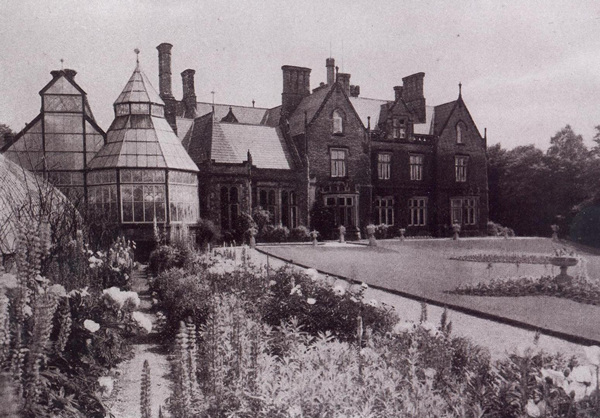Abney Hall is a substantial Victorian house surrounded by a park in Cheadle, near Stockport, Cheshire in the North-West of England. The hall dates back to 1847 and is a Grade II* listed building.
History[]
Early history[]
The foundations of the hall were laid in 1842 on the site of Cheadle Grove Print Works, which was built in 1760 and later burnt down; the hall was completed in 1847 but was remodelled in the 1850s and, considerably extended in the 1890s. It was originally called 'The Grove' after the print works and was the home of a mayor of Stockport, Alfred Orell, who died in the year of its completion. Abney was sold to James Watts (later Sir James Watts) who rebuilt the upper storey and added two short wings in the early 1850s. The architects for the alterations were Travis and Magnall, the Manchester firm which designed the Watts Warehouse on Portland Street in Manchester. However, hardly was the work by Travis and Magnall complete, when James Watts was in inspired to engage the architect and designer A. W. N. Pugin and his colleagues who had created the Gothic Court at the 1851 Great Exhibition in the Crystal Palace to make further substantial alterations.
James Watts was responsible for renaming it 'Abney Hall' after, in the words of his son, "Sir Thomas Abney who entertained Sir Isaac Watts for thirty years" [In reality Rev. Dr. Isaac Watts, rather than "Sir Isaac".].
In the 1890s Abney Hall was further altered and substantially extended by the architect and interior designer George Faulkner Armitage.
In 1912, a valuation and inventory was taken for insurance purposes by Waring & Gillow Ltd who valued the contents of Abney Hall and Buckley Hall (a detached stone and lime building within the grounds that was demolished in 1963) at £13,150 5s 0d.
Later history[]
Abney Hall was sold 1958 for £14,000 to Cheadle and Gatley Urban District Council which adapted it and opened it as Cheadle Town Hall in 1959. Stockport Metropolitan Borough Council took it over in 1974 and moved much of the remaining historical furniture from the hall to Bramall Hall and Lyme Hall. Parts of the grounds were sold until about a tenth of the original area remains. The hall is used as offices, though it is generally opened to the public under the auspices of the Civic Trust's Heritage Open Days scheme in September, and the grounds are open to the public all year round.
Grounds[]
The park was originally part of the Mersey flood plain, and much of the land is still very damp. This land has now formed wet meadows, which are becoming increasingly rare in Stockport as land is drained for development. Abney Hall is one of the few places in Stockport to feature such wetlands.
Agatha Christie[]
The last private owner of Abney Hall, another James Watts, was Agatha Christie's brother-in-law. Mrs. Christie often visited the Hall and wrote two stories from there: the novel After the Funeral and the short story The Adventure of the Christmas Pudding, which is part of a collection of short stories of the same name. The Hall was also used as a basis for Chimneys, a country house and seat of the fictional Marquesses of Caterham, in The Secret of Chimneys and The Seven Dials Mystery. Many references to various places around Cheadle can be found in her books. Vanessa Wagstaff writes, "Abney became Agatha's greatest inspiration for country-house life, with all the servants and grandeur which have been woven into her plots. The descriptions of the fictional Styles Court, Chimneys, Stoneygates and the other houses in her stories are mostly Abney in various forms."
The Watts also owned another property just 14 miles away near the village of Hayfield called Upper House. Agatha Christie also stayed there during the times she visited her sister. In between the two is the town of Marple, which inspired the name for Christie's famous female detective.
Abney Hall is probably where Agatha Christie wrote at least some of the short stories, perhaps the first 6, which went into The Thirteen Problems.[1]
Visitors[]
Abney Hall has had numerous famous visitors, some of whom are listed below:
- In 1857, Prince Albert visited the Hall during a two-day visit to Manchester and described it as 'one of the most princely mansions in the neighbourhood'.
- Agatha Christie's brother-in-law, James Watts, was the last private owner of the Hall and Mrs. Christie often spent time there.
- Benjamin Disraeli
- E.M. Forster
- William Ewart Gladstone
Current Uses[]
In April 2011, Stockport Metropolitan Borough Council granted Bioticfit, a health and fitness club in Cheadle, a licence for the park to be used for outdoor fitness classes and personal training for local residents. Bioticfit has currently attracted 700 residents as a fitness and health alternative to leisure centres and gyms and continues to run boot camps at the park.




